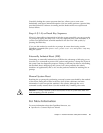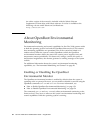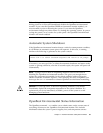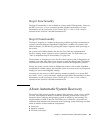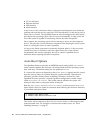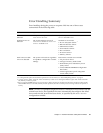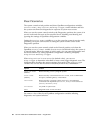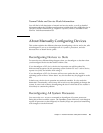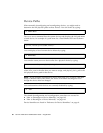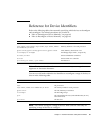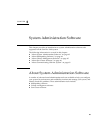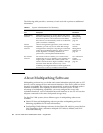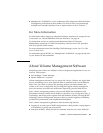
Chapter 4 Network Interfaces and System Firmware 59
Normal Mode and Service Mode Information
You will find a full description of normal and service modes, as well as detailed
information about the OpenBoot configuration variables that affect ASR behavior, in
OpenBoot PROM Enhancements for Diagnostic Operation, which is available on the
Sun Fire V490 Documentation CD.
About Manually Configuring Devices
This section explains the difference between deconfiguring a device and a slot, tells
what happens if you try to deconfigure all of a system’s processors, and also
discusses how to obtain device paths.
Deconfiguring Devices vs. Slots
For some devices, different things happen when you deconfigure a slot than when
you deconfigure the device that resides within a slot.
If you deconfigure a PCI device, the device in question can still be probed by
firmware and recognized by the operating system. Solaris OS “sees” such a device,
reports it as failed, and refrains from using it.
If you deconfigure a PCI slot, firmware will not even probe the slot, and the
operating system will not “know about” any devices that may be plugged in to the
slot.
In both cases, the devices in question are rendered unusable. So why make the
distinction? Occasionally, a device may fail in such a way that probing it disrupts the
system. In cases such as these, deconfiguring the slot in which the device resides is
more likely to contain the problem.
Deconfiguring All System Processors
You can use the asr-disable command to deconfigure all system processors.
Doing this will not crash the system. The OpenBoot system firmware, even though it
reports all processors as deconfigured, in actuality keeps one processor functioning
well enough to run the firmware.



